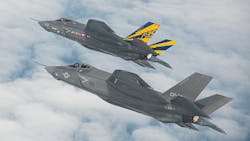Trump's F-35 Calls Came With a Surprise: Rival CEO Was Listening
Days before taking office, President-elect Donald Trump made two surprise calls to the Air Force general managing the Pentagon’s largest weapons program, the Lockheed Martin Corp. (IW 500/25) F-35 jet.
Listening in on one of those calls was Dennis Muilenburg -- the CEO of Lockheed’s chief rival, Boeing Co. (IW 500/9)
Trump, who has repeatedly criticized the $379 billion F-35 program as “out of control,” made the highly unusual calls to Lieutenant General Chris Bogdan on Jan. 9 and Jan. 17, according to two people familiar with the matter. Muilenburg, whose company makes a fighter jet Trump has suggested might replace some of one F-35 model, was in the president-elect’s New York office for a meeting during the second call. He appeared caught off-guard but heard at least Trump’s end of the call, according to the people, who asked to remain anonymous discussing sensitive information.
After speaking with Trump, Bogdan wrote two three-page memos, titled “phone conversations with President-Elect,” dated Jan. 10 and 18th and stamped “For Official Use Only,” to limit distribution. They outlined Trump’s questions about the capabilities of Boeing’s Super Hornet fighter and how it might compete against Lockheed’s F-35C, said the people. About a dozen Pentagon officials were alerted to the calls after they occurred, the people said.
‘It Creates Chaos’
Since winning election, Trump has stressed his experience in real estate as evidence he can get taxpayers a better deal on expensive Pentagon programs. Boeing, too, faced Trump’s wrath when he criticized potential spending on a new version of the Air Force One presidential airplane. But Trump’s calls to a uniformed program manager to discuss a contract that was completed 16 years ago were unprecedented and potentially disruptive, said a defense analyst.
“When a president ignores the chain of command by going directly to a program manager, it creates chaos in the system,” said Loren Thompson, an analyst with the Lexington Institute in Arlington, Virginia, who’s followed the F-35 program since Lockheed beat Boeing in the winner-take-all contract in October 2001.
“Behavior that looks decisive in the business world can unhinge a military organization that depends on order and discipline,” said Thompson, who also consults for Lockheed.
Following his Jan. 17 meeting with Trump, Muilenburg said he “made some great progress” in his talks with the president-elect.
“We discussed Air Force One, we discussed fighter aircraft,” Muilenburg told reporters at Trump Tower in New York.
Boeing spokesman Todd Blecher said in an e-mail, “I have nothing to add to what Mr. Muilenburg said to reporters after” his Trump Tower meeting on the 17th.
Congressional Hearing
Lockheed declined to comment. The White House didn’t immediately respond to a request for comment. Bogdan’s spokesman, Joe DellaVedova, declined to answer any questions about the calls or provide the memos, which Bloomberg has requested under the Freedom of Information Act.
Bogdan may be asked about the calls when he testifies on the F-35 program Thursday before a subcommittee of the House Armed Services Committee. He first met Trump Dec. 21 at his Palm Beach resort during an official visit by 11 military officers.
Trump has shaken the defense industry -- and put all large U.S. companies with government contracts on notice -- with his frequent Twitter posts about business issues ranging from the F-35 to sales of his daughter Ivanka’s brand at Nordstrom Inc. stores. Trump’s phone calls to the Pentagon came after a December tweet: “Based on the tremendous cost and cost overruns of the Lockheed Martin F-35, I have asked Boeing to price-out a comparable F-18 Super Hornet!”
Aircraft Have Different Capabilities
There’s probably not much Boeing could do to make its jet comparable to the F-35. The two aircraft have different capabilities and mission requirements. Moreover, in an effort to drive the fighter’s costs down, the F-35 has been marketed to allies around the world, with production and maintenance contracts spread from the U.K. to Australia.
The U.S. Air Force, which plans to buy 1,763 of the F-35A model jets, would not fly Boeing’s minimally stealthy “fourth-generation” Super Hornet, which is designed for aircraft carrier operations. As a so-called fifth-generation fighter, the F-35 is stealthier and is equipped with more advanced radar, sensors and communications systems.
The Navy version of the F-35 is easier to target because it’s not scheduled to be operational until August 2018 at the earliest. The service plans to buy only 260 carrier models of the plane; the Marine Corps will buy 80 of the Navy model and 340 of a version capable of short takeoffs and vertical landings, according to the Congressional Research Service. Lockheed has delivered 26 of the Navy jets to date, with four more on order, according to spokesman Mike Rein.
Pentagon Review
Aerospace analyst Richard Aboulafia said in an e-mail that “Trump seems to really like interfering in the requirements process” but “hopefully, he realizes that the Super Hornet/F-35 battle only impacts a very small part of the F-35 program.”
Nevertheless, Trump is not the first person to suggest that the F/A-18E/F could replace some F-35s. The Pentagon’s first Quadrennial Defense Review in May 1997 said that “should Joint Strike Fighter development be delayed additional F/A-18E/Fs” beyond planned quantities “may be added later as appropriate to sustain planned forces.”
Defense Secretary James Mattis in a memo last month translated Trump’s tweet into action when he asked Deputy Defense Secretary Robert Work to oversee a review that “compares F-35C and F/A-18E/F operational capabilities and assesses the extent that F/A-18E/F improvements (an advanced Super Hornet) can be made in order to provide a competitive, cost effective, fighter aircraft alternative.”
Under current plans, the Pentagon is scheduled to increase overall purchases of the F-35 in the coming fiscal year to 70 from 63 this year. Purchases would grow to 80 aircraft in fiscal 2019, and there’s a pending “block buy” of 450 aircraft after that.
By Tony Capaccio
About the Author
Bloomberg
Licensed content from Bloomberg, copyright 2016.
